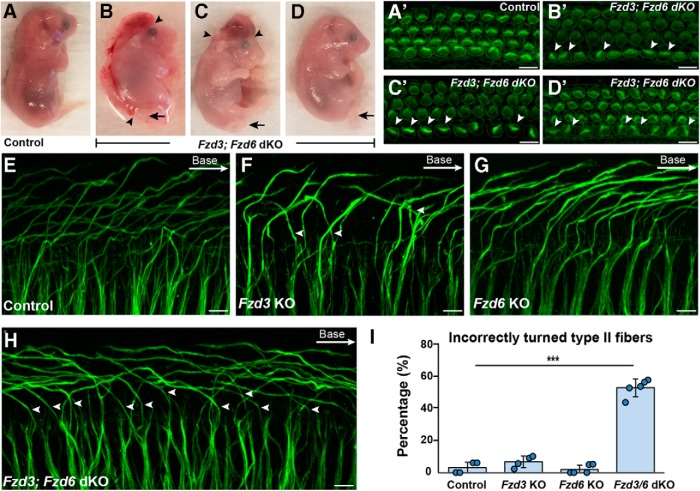Figure 3.
Fzd3 and Fzd6 act redundantly to direct Type II SGN turning. A–D, All Fzd3;Fzd6 dKOs have characteristic looped tails (arrows) but variable neural tube defects ranging from craniorachischisis (B) to exencephaly (C) to normal body axes (D). C, D, Arrowheads indicate the anterior and posterior extent of the neural tube defect. A′–D′, Phalloidin staining of hair cell stereociliary bundles from cochlea dissected from Fzd3;Fzd6 dKO embryos (corresponding to B,C,D) shows that all have misoriented bundles (arrowheads) regardless of the severity of the neural tube defect. E–H, NF200 immunolabeling of Type II peripheral axons shows that the majority project toward the cochlear base in littermate controls (E), Fzd3 KOs (F), and Fzd6 KOs (G), whereas in Fzd3;Fzd6 dKOs, (H) many turn incorrectly toward the cochlear apex (arrowheads). I, The average frequency of incorrectly turned Type II peripheral axons in dKO, single KO, and littermate control animals. Data are mean ± SD with overlying circles reporting to the frequency of turning errors for individual mice. All images and quantification were collected from the basal turn of E18.5 cochlea with a single cochlea analyzed from each mouse: Control (n = 4, 159 axons), Fzd3 KO (n = 4, 178 axons), Fzd6 KO (n = 5, 240 axons), Fzd3;Fzd6 dKO (n = 5, 231 axons). ***p ≤ 0.001, Fzd3;Fzd6 dKOs versus littermate controls (Student's t test). Scale bars, 10 μm.

